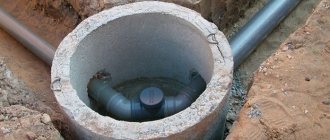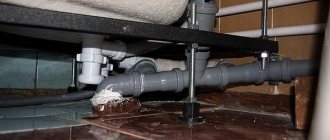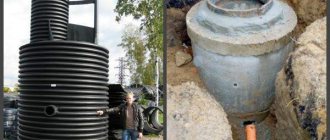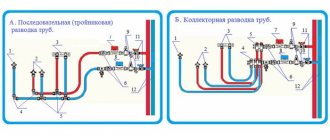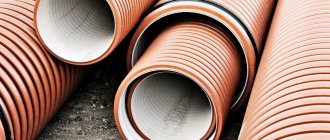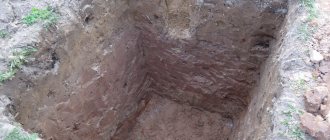A separate section of engineering communications design is sewer system planning. Owners of cottages and country houses often have to independently draw up diagrams and install equipment, so knowing the nuances of organizing work is simply necessary.
The efficiency of the system largely depends on whether the sewerage installation in a private house is done correctly - the internal pipe system and the equipment connected to them. For competent design, it is important to take into account everything: from the choice of components to the material used to manufacture individual elements. And we will tell you how to do it correctly.
Sewer system design
Unlike electricity, gas, and water supply systems, which are installed in accordance with documentation certified by certain authorities, sewerage systems on your own land plot and in your house are allowed to be installed without permits.
However, one cannot do without a project, as it will protect against errors associated with violation of generally accepted requirements.
For example, one of the common violations is failure to respect the boundaries of the sanitary zone when installing a drainage pit. The supply and drain systems must not come into contact with each other.
Option for arranging communications in a private one-story house - external water supply and sewerage systems are located on opposite sides of the building
The installation of internal wiring is often associated with errors in the organization of ventilation, incorrect choice of pipe diameter or angle of inclination.
The construction of an axonometric diagram is usually carried out by specialists. They also carry out hydraulic calculations of the internal network and the highway located on the outside of the building. Now there is a more interesting option - creating a sewer model in 3D format.
3D modeling programs allow you to create an accurate and complete project that simplifies the selection of pipes, fittings, fasteners, and installation methods as much as possible.
They turn to specialists for a project when they want to reduce risks. But there is another option - study sanitary and technical standards, familiarize yourself with internal wiring diagrams, learn to understand the quality of plumbing equipment and draw up a project yourself.
Placement of important system components
The peculiarity of an autonomous sewerage system is that the principles of its arrangement depend on each component in the overall system.
For example, the criterion for choosing a wastewater storage tank is not only the number of people living in the cottage, but also the number of connected sources for draining technical and household water - from the house, garage, bathhouse, summer kitchen.
An approximate diagram of the interaction of internal and external sewerage systems with the mandatory installation of a drain riser. The cleaning function is performed by a factory-made septic tank
Based on location and main functions, sewerage is divided into 3 categories:
- internal - a network of pipelines from plumbing equipment to the exit outside, behind the walls of the house;
- external – highway from buildings (houses, bathhouses) to treatment equipment;
- cleaning systems - septic tanks, storage tanks, filtration fields, wells, settling tanks, biological treatment stations.
When considering the layout of the internal sewerage wiring in the house, you need to take into account the location of the external main and cleaning (storage) equipment.
If you have a centralized water collection and purification system, it is more rational to connect to a common pipe or treatment plant, if this option is cheaper than buying a septic tank
A full-fledged system includes not only drainage of household wastewater, but also a storm drain - a complex of stormwater inlets, gutters, pipes and connecting elements responsible for the collection and accumulation of rainwater.
Domestic sewerage on diagrams is usually designated K1, storm sewerage - K2. There is a third type - K3, but this is industrial equipment that has nothing to do with private farming.
Source data analysis
Everyone's sewerage conditions are different. Small country houses are characterized by the simplest system: a riser with a pipe outlet to the bathroom, where a toilet and shower are installed.
Multi-room or two-story cottages are equipped with a network of pipelines, which also converge to one riser, less often to two.
Accordingly, projects for different houses will differ. To take into account all the nuances, it is necessary to answer a number of questions before choosing a scheme:
- What method of wastewater treatment is appropriate?
- Is it possible to connect to a centralized sewer?
- How much wastewater should a treatment plant accept per day?
- How often will the drainage system be used? (Year-round, seasonal, weekends).
- Is additional insulation required for pipes?
- What pipe material is optimal for creating a network?
- Will the waste drain by gravity or will a pump be required?
Most of the questions will arise during the design process, when you will need to select a wiring diagram and materials for its assembly.
To allow wastewater to flow by gravity, all pipes are placed not parallel to the floor, but at a slight angle. The slope is always directed from the plumbing fixtures towards the riser
The external pipeline is laid in the same way - with an inclination from the building to the pit or treatment plant.
Important rules for setting up an internal network:
- the cross-section of the pipes is selected taking into account the volume of waste;
- During the installation process, the principle of serial connection is used;
- the number of turns and sudden changes in elevation are kept to a minimum;
- ventilation equipment must be installed;
- think over installation locations for inspection hatches;
- choose thermal insulation for areas located in unheated areas.
If the pipeline is long, it is difficult to maintain the slope along the entire line, so additional equipment is installed - a circulation pump.
Work planning and scheme selection
The installation of sewer pipes is usually carried out together with the installation of a water supply system; accordingly, it is better to design these two systems together.
If we summarize all the documents that make up the project and try to act according to the rules, we will get the following list:
- General data - description and conditions for installation of water supply and sanitation systems based on regulatory documents.
- Explication of the premises (explanation of the diagram) indicating wet areas and the method of waterproofing them.
- Calculation of water consumption and wastewater disposal volumes taking into account standards.
- Floor plan for the location of the water supply system and axonometric diagram.
- Floor plan for sewerage location.
- Specification - a listing of all components with an indication of quantity or footage.
The last point is difficult to calculate unless there is an exact diagram (model) of pipelines indicating all turns and connections.
The diagram shows the diameters of the pipes, the height marks of the location of the main line relative to the UP (finished floor level), the location of the collectors and plumbing fixtures
Having diagrams developed for a specific building, wiring becomes much easier, and with the availability of modern materials, almost anyone can do it.
Therefore, owners of new private houses act as follows: they order documentation from designers, and do the installation themselves.
What pipes and components are needed for sewer installation
Sewerage installation is carried out using the following elements:
- Storage well or septic tank.
- Riser: for draining wastewater or biogases.
- Collectors for performing maintenance work.
- Pipes of various diameters.
The system will be complete only if fitting connecting elements are used in its creation.
Often the following pipes are purchased for installation work:
- Toilets and bidets are connected via pipes with a diameter of 110 mm.
- Bathrooms, showers and sinks are connected through pipes with a diameter of 50 mm.
- Sewer outlets or risers must have a diameter of more than 100 mm.
When choosing pipes, you should pay attention to what material they are made from. Recently, plastic pipes have become very popular because they have unique performance properties: practicality, long service life, low cost, good workability and many others.
Internal drainage system design
Internal sewerage has long taken on a standard form, which can be called the most rational: horizontal pipes are connected to risers located vertically. The riser is designed for an increased volume of wastewater, so its diameter is larger.
The movement of water from showers, toilets, sinks to the riser occurs either by gravity or by force - under the influence of pumping equipment
The internal wiring is connected to the external main, which consists of pipes of even larger diameter. The pipeline leads to a septic tank or other storage and treatment facility.
The location of the riser and the lines connected to it is subject to certain rules. For example, all wet areas are usually located in adjacent rooms: the kitchen is across the wall from the bathroom or toilet. Often the rooms are combined, an example of this is a shower room combined with a toilet.
It is customary to locate rooms in which tap water is actively used in close proximity due to practicality, ease of maintenance and savings in materials.
So the sewer pipe has a minimum length to the riser, therefore, the drains move outward by gravity, without additional force. The riser, in turn, is located at the exit of the sewer line and water supply from the house.
The closest plumbing fixture to it is the toilet. If you place a bathtub or kitchen between the toilet and the riser, then with each flush, water will be sucked out of the siphons.
Tilt is a necessary condition for a gravity system. The angle of inclination depends on the diameter of the pipe. There are parameters from which it is not recommended to deviate: for pipes 50-80 mm - 25-35 mm/meter of line.
If the pipe is wider than 80 mm, then the slope should be 20 mm/m. This situation is rare for private houses; this diameter is typical for outdoor pipes
Thus, the wiring in a country house should cover a minimum set of plumbing equipment: toilet, kitchen sink, shower (bath).
Residential buildings usually have more connected appliances, which may include additional sinks and toilets, a Jacuzzi, a dishwasher, a grease trap, a shredder, etc.
When installing the system, you cannot do without turns, although it is recommended to reduce their number. Every drop and turn is a chronic risk zone that provokes a blockage.
If it is not possible to avoid sharp turns, it is necessary to provide free access to them: either leave them open, or disguise them by equipping an inspection hatch.
According to the rules, a 90° turn is performed sequentially by two shaped parts providing an angle of 45°, and if space allows, then by three rotating parts (elbows) of 30° each.
The location of wet areas and the treatment plant or main line leading to the central pipe should be planned in advance. Ideally, they should be located next door, literally behind the wall.
The closer the sewerage elements are located to each other, the fewer problems its operation will cause.
To avoid gross mistakes during installation and to be on the safe side, we recommend studying SNiP 02.04.01-85 , which sets out in detail the norms and rules for installing water supply and sewerage systems.
Laying external networks
*
The drainage from the house should be 10–15 cm below the freezing level of the ground; in cold areas, thermal insulation of the pipeline is provided.
"Important! For drainage, choose pipes designed to be laid in the ground. It is better to use ceramic or cast iron pipes. Plastic materials intended for outdoor use are painted light brown or orange.”
At the design stage, access roads for sewage disposal vehicles are provided; they should not pass over pipelines.
The outlet is installed maintaining a slope of 2 - 3 cm/m of length. A 15 cm sand cushion is arranged in advance, which should be placed on top of the pipe before filling the trench with soil.
Figure 5. Installation of the outlet on a sand bed.
A technological hole is provided in the foundation, where a steel sleeve is mounted on the cement mortar, the diameter of which is 15–20 cm greater than the cross-section of the outlet pipe. The edges of the sleeve should protrude 150 mm beyond the outer and inner edges of the foundation. After final installation, the gap is sealed with polyurethane foam, and the outside of the foundation is equipped with waterproofing.
"Important! The riser is connected to the outlet by turning 45°. A 90° connection angle often leads to blockages in corners.”
Connection to a septic tank
The permitted distance from the septic tank to the foundation is at least 5 meters, and to outbuildings 3 meters.
The pipe entrance to the storage tank is located in the upper third of the wall of the septic tank (well) - this will prevent water from backing up into the house when the storage tank overflows or the centralized networks are clogged.
The top cover of the pit septic tank is equipped with an exhaust hood to remove gases. Otherwise, unpleasant odors will enter the house.
Figure 6. Correct connection of the outlet to the septic tank and exhaust diagram.
Ventilation system equipment
In order to comply with sanitary standards and make living in the house as comfortable as possible, the sewage system must be equipped with ventilation.
To prevent stagnation of gases in pipes and their penetration into living quarters, a vent pipe is installed.
A fan pipe is a simple vertical structure that resembles a riser in appearance. It is placed on the roof so that the fumes escape into the atmosphere.
You can refuse to install additional ventilation equipment, but provided that the private house is no higher than 2 floors and the load on the sewer network is minimal.
If many people live in the building, there are more than 2 bathrooms, and wastewater is discharged to a treatment facility, then the installation of a waste pipe is required. Thanks to it, the atmosphere in the house will be healthy, and the water from the water seals will not disappear anywhere due to the pressure difference in the network.
Selecting the location of the wastewater receiver and its parameters
Regardless of the type of receiver (recycling device or storage tank), its volume must be at least three times the daily water consumption for everyone living in the house . Existing standards determine the average value per person - 200 liters, based on which the volume of the tank is calculated as 600 liters (200x3), multiplied by the number of people. When using treatment facilities with several tanks connected in series, their total volume is taken into account.
The installation location of the receiver is determined taking into account certain requirements.
- The structure is installed in the lowest place of the site, if the latter has complex terrain.
- Distances to important objects must comply with accepted standards:
- to the source of drinking water - up to 50 meters (depending on the type of receiving device, groundwater level),
- to the road - at least 5 m,
— to a reservoir or other open body of water – 30 m,
- to a residential building - 5 m.
Layout of the sewerage structure on the site
Features of wiring in a multi-storey building
The number of risers does not increase due to the presence of the 2nd or 3rd floors, but the connection diagram becomes more complicated, since branches are present on all floors. For multi-storey buildings there is a “code” set out in SNiP documents.
According to the rules, functionally identical rooms should be located on top of each other. This mainly applies to bathrooms, since there is usually only one kitchen in a private house
The length of the risers increases and the presence of a drain pipe becomes mandatory. It extends above the roof approximately 1.2-1.5 m in height. Instead of a fan pipe, a vacuum valve is sometimes used.
The protection of the riser in the ceilings is carried out using compensators necessary to suppress linear expansion. The rest of the installation principles, as well as connecting the taps, remain the same.
In one-story cottages and country houses, the basement is usually used as a cellar or storage room. In multi-storey buildings, garages, swimming pools, and guest rooms are often located in the basement
There are rules for basements and ground floors equipped with toilets. If the toilet is located below the level of the treatment plant, a fecal pump will be required to move the wastewater.
The pumping system is more expensive than the gravity one and is energy dependent, which has its disadvantages, especially with frequent power outages.



